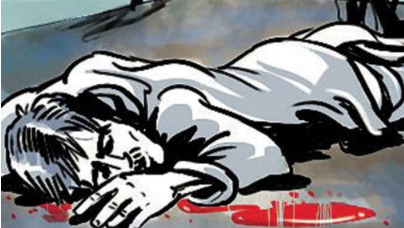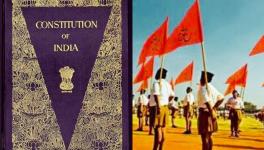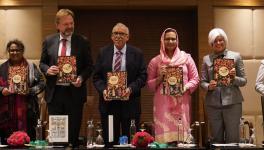Atrocities Against dalits Continue Unabated in Gujarat

Image Courtesy: DNA India
On May 22, Jignesh Mevani, MLA from Vadgam, Gujarat, released a strongly worded statement on his Facebook page, following the killing of Rajesh Sondarva. Sondarva was a 21-year-old dalit murdered by upper caste Hindu men in Rajkot, Gujarat. Earlier in May, a village sarpach in the state’s Mehsana district issued a diktat for the social boycott of a dalit man and his family, because he rode a horse at his wedding. Mevani titled the statement: “Gujarat: Hell on Earth for Dalits and Adivasis”. He wrote: “In 2019, the Gujarat government revealed a 32% rise in crimes against Scheduled Castes between 2013 and 2017, and a 55% rise in crimes against Scheduled Tribes for the same period”. Mevani also reminded people that the Scheduled Caste and Scheduled Tribe (Prevention of Atrocities) Act (PoA Act) had been enacted to ensure that state agencies could take proactive measures to prevent atrocities. He added that the Gujarat state government had failed to either take corrective measures or to ensure that the victims and their families get justice when crimes are committed against them. Speaking to Newsclick and the Indian Cultural Forum, Mevani said, “In the state of Gujarat there is a mindset among upper-caste people that absolutely nothing is going to happen to them even if they keep subjecting Dalits to violence, discrimination and brutality. So the strong message that should have gone from the administration, the police and the government has not gone at all. Rather, through callousness and indifference, the BJP government in Gujarat is telling upper caste people that it is only them that they stand for.”
After the results of the 2019 General Elections were announced, Modi made a speech about minorities to the NDA MPs. He said that minorities live in an “imagined fear, this imagined atmosphere and this environment of dread was created – thereby keeping them aside, keeping them repressed, and only using them during elections.” Modi’s staggering capacity for Newspeak aside, the reality he dismisses as a “myth” is quite dire. That is true of both the state he ruled as Chief Minister from 2001-2014 and the nation that he will take over for a second term.
What atrocities?
Political figures like Jignesh Mevani who have fought for civil rights for years have a sobering side to tell. To understand the attitude of the government of Gujarat, Mewani says we have to take another look at the death of the Right to Information (RTI) activist Nanjibhai Sondarva. Nanjibhai was the father of Rajesh Sondarva. In May 2018, he was clubbed to death for filing an RTI application that sought details on financial irregularities for a road recently built to the village. The Manekawada village sarpanch was one among the accused. An article in CounterView written in the days following Nanjibhai’s murder, says that 11 RTI activists had been murdered for questioning the “Gujarat Model of Development”. The Commonwealth Human Rights Initiative (CHRI), an independent international organisation, has been “mapping” the assault, harassment and killing of RTI activists based on news media reports. According to it, between 2008 and 2019, 45 incidents have occurred in Gujarat. 12 were murders and one was a suicide. Earlier this year, Scroll.in had taken a look at the steady attempts to dilute the RTI Act by the Modi government. It is an unhappy read.
In the case of Gujarat, a state that consistently brutalises dalits, this is what happens to those who have the courage to question upper castes wielding administrative power. Mevani alleges that there was a video made by Nanjibhai that was widely circulated before his death in which he expressed fear for his life. Mewani asks why it is that the PoA Act is not being implemented properly to prevent atrocities. “Why did the local police, concerned Superintendent and District Magistrate not take cognisance? The result? Nanjibhai Sondarva, one of the best RTI activists we had from the dalit community was killed on May 9, last year” he says. “Instead of being ashamed about their failure, the police and the Gujarat government have gone into deeper slumber. Within a year Rajesh Sondarva, his son, was requesting adequate protection so that at least he is not killed. Police protection was provided, but the attitude of the operatives was apathetic. These casteist-feudal forces are so sure that nobody is going to touch them and that the state is not going take any stringent action against them. This boy was also killed last week.” Rajesh had refused to withdraw the case against the accused in his father’s murder. The accused were out on bail. An article by The Wire, quotes social rights activist and Association for Democratic Reform (ADR) Gujarat state coordinator Pankti Jog. Jog reportedly told them that Rajesh managed to identify his attackers. Right before losing consciousness, he apparently informed someone that he had been attacked by those accused of his father's murder. In the same article, Jog adds that Mevani has been in touch with the Sondarva family in order to help them with the case.
The May 7 incident in Mehsana is one of four incidents to occur within a week in Gujarat and all of them just concerning dalit wedding processions. On May 12, in Khambhisar village, a wedding procession was pelted with stones by upper-caste people. It was reported on May 28, that the horse used by the groom succumbed to its injuries.
On May 20, in the Baroda taluk, a dalit couple, identified as Tarulataben Mackwana and Pravin Mackwana, was attacked by over 200 upper caste men for a Facebook post. The husband in a Facebook post had said that dalits were not being allowed to get married in the village temple by the state government. The attack itself appears to have occurred on Monday, May 20, but came to light on Thursday, May 23, after the FIR was filed. To add insult to this grievous injury, Pravin Mackwana, who wrote the Facebook post, has also been booked for “promoting enmity between different groups.”
For a sordid, but by no means complete, list of injustices and discriminatory practices from 2014-18, the extract from Bhed-Bharat, by Martin Macwan, is necessary reading. Martin Macwan is the founder of the Navsarjan Trust (1989) and the Dalit Shakti Kendra (1999). He is an activist who has fought caste injustices in Gujarat and other parts of India for 40 years.
Scheduled Castes and Scheduled Tribes (Prevention of Atrocities) Act, 1989
The National Coalition for Strengthening SCs and STs, comprising of 70 organisations, activists and experts, published a “Report Card” in 2010, reviewing 20 years of the PoA Act. This 70 page report card also provides a historical sketch of the Act. According to it, post-Independence, it was clear that despite Article 17 of the Constitution abolishing and forbidding “untouchability”, discriminatory practices continued. To check this, the 1955 Untouchability Offences Act, was amended and renamed the Protection of Civil Rights (PCR) Act, 1976. Though not entirely sufficient, it continues to exist. To quote the National Coalition for Strengthening SCs and STs, a “more comprehensive and more punitive Act was required to protect SCs and STs from violence committed by other communities”. This was the origin of the SC/ST (PoA) Act, 1989.
In its introduction to the PoA Act, the above report highlights how the term “atrocities” was defined for the first time. These are enlisted in Chapter II, “Offences of Atrocities” when committed by “whoever, not being a member of a Scheduled Caste or a Scheduled Tribe”. In 2015, the Scheduled Castes and Scheduled Tribes (Prevention of Atrocities) Amendment Act was passed. The entire PoA Act including these amendments can be read here. The announcement for the amendments can also be perused by those interested. Reading through them, one will see that the atrocities mentioned in the article, and the countless others that SCs and STs are routinely subjected to, are in violation of this Act. In March 2018, the Supreme Court passed a verdict that diluted the PoA Act claiming that it was being used for “blackmail”. This understandably led to massive backlash. In August the same year, the Government of India passed the Scheduled Castes and the Scheduled Tribes (Prevention of Atrocities) Amendment Act, 2018, effectively nullifying the effects of the verdict. While this seems a progressive and proactive measure, one is inclined to wonder how much this had to do with the then upcoming state and Lok Sabha elections.
In the second chapter of the Scheduled Castes and Scheduled Tribes (Prevention of Atrocities)Act report for the year 2016 the following claims are made about Gujarat among other states:
- Special courts to ensure speedy trials of cases under PoA Act: Out of 33 districts, 16 special courts in Gujarat.
- Setting up of (a) SC/ST Protection Cells at State Headquarters, and (b) Special Police Stations for SC/ST: SC/ST Protection Cell at the State headquarters under the charge of a DGP, ADGP/IGP
- Nodal Officers for coordinating the functioning of District Magistrates and Superintendents of Police
- Delineation of “Identified areas” or “atrocity prone areas” + Spl Officers
The same claims had been made in reports from the year 2010 and 2013.
A review of the PoA and PCR Acts available on the same website, was presented in a meeting of State Secretaries in February this year. It offers dismal information about Gujarat and many other states. 1321 cases of atrocities against SCs were registered in Gujarat in 2016. Gujarat also features in the list of “States where conviction rate was in single digit in regard to PoA Act related cases, in conjunction with the IPC, during 2016, as against all India conviction rate of 24.9 percent”. The conviction rate was 0.4 percent. The number of cases pending at the end of 2016, in Exclusive Special Courts in Gujarat stood at 8998. Neither of these latter two lists are specific as to whether it is regarding both SCs and STs. It must be noted that the National Crime Records Bureau (NCRB) data that is publicly available stops after 2016.
The “Report Card” mentioned earlier, cites another report made by the National Human Rights Commission (NHRC) with regard to non-registration of cases under the PoA Act. It alleges that due to police collusion with dominant caste or departmental suppression of crime rates figures, crimes are registered under the IPC instead of the PoA Act. Also referring to a study made by Martin Macwan and Harshad Desai, the “Report Card” gives one such example from Gujarat. From a “sample study covering 11 atrocity-prone districts exposed that between 1990 – 1993, 36 percent atrocities cases were not registered under PoA Act. In 84.4 percent of cases where the act was applied, the cases were registered under wrong provisions with a view to concealing the violent nature of the incidents.” The study also says that between 1995-2007, less than one-third of the crimes against SCs/STs were registered under the PoA. We spoke to Paul Divaker, one of the founding members of the National Campaign on Dalit Human Rights (NCDHR). He says that the trend of registering cases under the IPC instead of the PoA Act continues.
Institutionalised discrimination and abuse are some aspects of caste based atrocities that need to be spoken of more. In Bhed-Bharat, Martin Macwan notes the higher incarceration rates of Dalits: “Around 32.9 percent of all convicts and 23.4 percent of under-trials in Gujarat’s prisons are dalits, a community that forms just about 6.7 percent of the state’s overall population” as of 2014. Access to health care, especially pre and post-natal care, is also liable to caste-based discrimination. He notes that in 2015, in Hajipur, Patan District, a three-year-old dalit girl was stopped at the gate of Anganwadi Centre No. 160 and told to go to Centre No. 159, “the one for dalits”. Keeping this mind, the question whether discrimination against dalit Aganwadi and ASHA workers by upper caste women who may refuse to be treated by them also arises. How does the PoA Act then ensure right to health care and right to work? How does it protect against systemic discrimination as illustrated by high incarceration rates?
Paul Divaker points out that in general in the country, there are discriminatory practices with regard to schools (right to education), wage labour and corporate recruitment. He told us that the PoA Act does not take such forms of discrimination into consideration. He says that they are drafting a proposal for an “Equal Opportunities and Anti-Discriminatory Act”. They hope to submit this to people in the government who are likely to respond to it.
Divaker says that the lack of authoritative data will soon become a problem for those working for civil liberties and the rights of minorities and marginalised people. The example of the NCRB data is worrying. Divaker says that its effects will be crippling.
After being voted back to power, Modi talked to his MPs about reaching out to minorities. The Hindutva forces that helped bring him to power, on the other hand, assault and murder minorities with increasing impunity. The number of cases reported just after the election results were announced on May 23 are telling. Against this, the talk of inclusivity and safeguarding minority rights simply looks like an attempt to mislead international news media. The article in Time magazine — that called him the Divider-in-Chief, the Mehdi Hassan interview with Nalin Kohli in Al Jazeera, and numerous other international features and stories, have drawn attention to sectarianism and violence under the Modi Govt. If Modi believes that he can do away with international scrutiny with a few well-crafted words, it doubly falls on national news sources to dispel misinformation and propaganda.
Get the latest reports & analysis with people's perspective on Protests, movements & deep analytical videos, discussions of the current affairs in your Telegram app. Subscribe to NewsClick's Telegram channel & get Real-Time updates on stories, as they get published on our website.
























